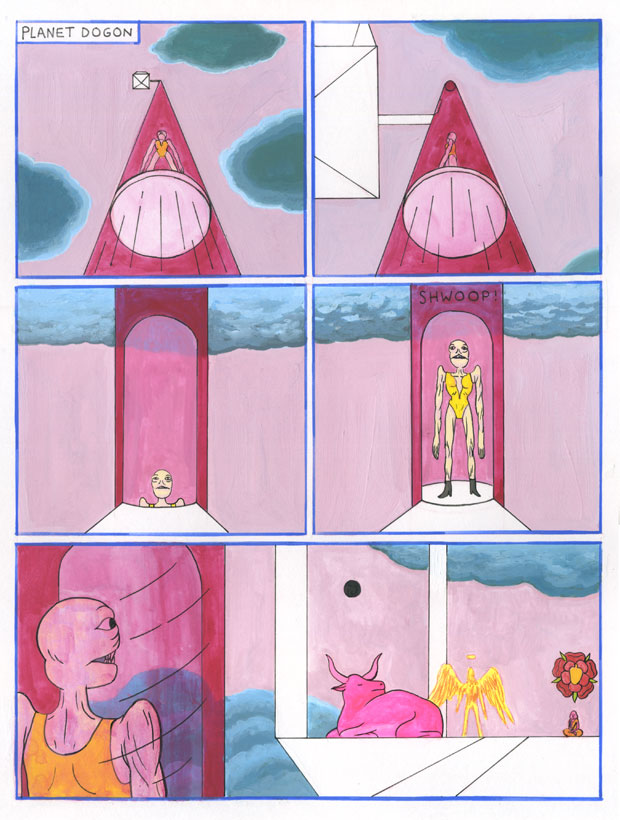Andreidignart
Shared posts
Midnight City #9 – The Egyptian
Music For Neanderthals Outtake
Unused & unfinished page from ‘Music For Neanderthals’ (collected in Beta Testing the Apocalypse).
Sem camisa não pode
As regras estabelecidas pelo consórcio que administrará o – conforme diz a placa colocada perto da minha rua – “Maracanã Stadium”, são mais um passo no processo sinistro de gentrificação dos estádios de futebol no Brasil. Uso gentrificação no sentido dado ao termo pelos estudos pioneiros de Ruth Glass e Neil Smith; aquele que, grosso modo, designa um processo de aburguesamento de espaços nas grandes metrópoles e gera o afastamento das camadas populares do local modificado. O espaço gentrificado passa a ser gerido prioritariamente pelos interesses do grande capital. Este processo de submissão ao capital é, em geral, acompanhado de discursos legitimadores que vão desde o “tratamento ecologicamente correto” até o da “gestão financeira responsável”.
Goste-se ou não do jogo, futebol no Brasil é cultura, pois se consolidou como um campo de elaboração de símbolos, projeções de vida, construção de laços de coesão social, afirmação identitária e tensão criadora, com todos os aspectos positivos e negativos implicados neste processo. Nossas maneiras de jogar bola e torcer por um time dizem muito sobre as contradições, violências, alegrias, tragédias, festas e dores que nos constituem simbolicamente como povo.
Estamos assistindo, com impressionante rapidez, a mudança de perfil do frequentador dos jogos. Sai o torcedor e entra o consumidor. A ideia é mesmo reservar os estádios para as chamadas “pessoas de bem”, entendidas como aquelas que podem pagar caro pelo ingresso e pela camisa oficial do clube. O tal do consórcio, baseado no “padrão FIFA”, pretende inclusive estabelecer o traje com que o torcedor deve ir aos jogos. Sem camisa, não pode. Bandeirões, bumbos e similares também estão vetados.
O presidente do consórcio, João Borba, declarou o seguinte:
- Fui no último fim de semana às finais do tênis em Wimbledon e, no convite, estava escrito que não é recomendável ir com determinada roupa. Quando um inglês lê “não recomendável”, entende que não deve usar aquele tipo de roupa.
Então é isso. Os novos donos do jogo querem um público de tênis no Maracanã, vestido com adequação de lordes britânicos. O próximo passo será pedir silêncio e permitir apenas palmas protocolares após as jogadas mais bonitas?
Não é inocente, neste contexto, a sistemática campanha pelo futebol-família, termo exaustivamente repetido pelos galvões da vida, ou a utilização de orquestras sinfônicas e animadores assépticos para comandar o público, pouco afeito às torcidas tradicionais. O discurso do combate à violência dos torcedores é instrumentalizado para atingir outro objetivo, o de higienizar os estádios. A expressão higienizar, diga-se, foi largamente utilizada pelos homens do poder no início do século XX, quando combater epidemias passava também pela repressão às manifestações culturais das camadas populares urbanas e o afastamento dos pobres da região central da cidade.
Esse processo vai, evidentemente, culminar com a realização da Copa de 2014 no país e se consolidar. A clientela das novas arenas será formada por turistas e brasileiros de médio e alto poder aquisitivo, sem relações emocionais mais profundas com o futebol. O torcedor de fé – aquele que acompanha o cotidiano do seu time e faz do ato de assistir ao jogo uma reinvenção da vida – estará do outro lado da telinha, ou ao pé do rádio, tomando uma gelada, que ninguém é de ferro.
Como ele, o torcedor descartado e combatido como vírus epidêmico, me resta morrer feito bandido em filme do Velho Oeste; atirando broncas contra quem me mata.
O Maracanã, minha Itabira, é apenas uma fotografia na parede. Mas como dói.
Romário acusa a Câmara na Câmara
Senhor Presidente
Prezados Colegas Deputados
Depois de algum tempo, volto a esta tribuna para denunciar um fato que, no meu entender, é de extrema gravidade.
Na noite da última terça-feira (9), o presidente da Confederação Brasileira de Futebol, Senhor José Maria Marin, foi recepcionado aqui em Brasília por mais ou menos 25 parlamentares.
Não estranho esse fato. Afinal, é comum e próprio da democracia o encontro entre deputados e senadores com autoridades de órgãos privados.
O problema, é que a reunião-jantar tratou, também, de um tema que está em discussão nesta Casa ainda de forma preliminar, mas envolve um duro golpe nas finanças públicas do nosso país.
Refiro-me à proposta em elaboração pelo Ministério do Esporte para anistiar uma dívida em torno de R$ 3 bilhões dos clubes de futebol.
Essa dívida, para quem não acompanha o assunto, é para com o INSS, Imposto de Renda e Fundo de Garantia. Ao longo dos últimos 20 anos, os clubes de futebol não repassaram ao fisco os valores devidos. A dívida cresceu e se tornou gigantesca pelo acúmulo de juros, principalmente.
Agora, por iniciativa do Ministério do Esporte, está em elaboração uma medida provisória para anistiar os clubes devedores.
Este assunto, foi discutido há mais ou menos dois meses na Comissão de Turismo e Desporto, da qual sou presidente.
Naquela ocasião, vários deputados que acompanham o assunto participaram da reunião com o diretor de Futebol do Ministério do Esporte, Antônio José Carvalho do Nascimento Filho, o Toninho.
E nunca mais, o assunto voltou a ser tratado nesta Comissão de Turismo e Desporto, o foro legítimo para tal.
No entanto, meus colegas trocaram o nosso ambiente de trabalho para se reunir fora da Câmara dos Deputados, na calada da noite com um cartola que representa a desmoralização da gestão esportiva, o Senhor Marin.
Lembro que Marin é um dirigente que teve íntima ligação com a ditadura militar brasileira. Roubou medalha, terreno público, além da acusação de roubo de energia do vizinho, mas, hoje, é recebido com pompas por deputados que, por respeito à ética, declino citar seus nomes, por enquanto.
Porém, tal reunião contou com a presença de pessoas estranhas ao corpo parlamentar, como o lobista da CBF, Vandenbergue Machado e outros, que opinam sobre tema que não lhes compete.
Em sua investida em Brasília, nesta quarta-feira o Senhor Marin também visitou o presidente desta Casa, o excelentíssimo senhor deputado Henrique Eduardo Alves.
E entregou ao representante maior do Legislativo brasileiro convite para que seja o chefe da delegação num amistoso da Seleção, em setembro próximo, nos Estados Unidos.
O que significa essa ação oportunista de José Maria Marin ao Parlamento Brasileiro, com convites e reuniões?
É uma ousada tentativa para silenciar a Câmara dos Deputados com a troca de favores e benefícios?
Ou Marin já está apresentando a fatura da CBF por ter concedido centenas de ingressos a parlamentares, durante os jogos da Seleção Brasileira na Copa das Confederações?
Precisamos repudiar esse comportamento, pois ele sugere nos intimidar diante do poder do futebol. Já basta o que fazia o presidente anterior, Sr. Ricardo Teixeira.
Não podemos silenciar nem nos dobrar quando um personagem que não honrou os princípios democráticos na história do Brasil, nem uma das maiores entidades esportivas do mundo, agora se aproxima do Legislativo para ter benefícios ilegais, imorais e altamente suspeitos.
Não fosse por isso, é preciso considerar que a proposta dos clubes, com apoio da CBF e do Ministério do Esporte para perdoar a dívida de mais de R$ 3 Bilhões é discutida fora do âmbito devido.
E, pior, essa proposta de anistia do fisco acabará premiando o caloteiro de ontem, onerando significativa e moralmente o cofre público e o contribuinte em geral. Muitos deles aproveitaram o calote para enriquecer ilicitamente, é claro que não me refiro a todos, nem as atuais gestões.
Sabemos que a presidente Dilma Rousseff prepara um rigoroso corte no Orçamento da República para tentar fazer frente à crise econômica que nos ronda.
E é num momento assim e diante do rigor que o governo quer impor às contas públicas que os cartolas querem ser anistiados do calote que impuseram ao fisco?
É difícil entender que essa proposta tenha o apoio do Ministério do Esporte!
É difícil entender que essa proposta volte a ser discutida de forma escondida e sem levar em conta o recado das ruas, das recentes manifestações que clamaram contra os abusos do Poder.
É mais difícil entender que órgão do próprio governo, o Ministério do Esporte, e representantes populares, os senhores deputados, abracem essa causa da anistia aos clubes de futebol no momento em que o Palácio do Planalto pede rigor nos gastos públicos e agilidade na arrecadação dos impostos para enfrentar a ameaça inflacionária e evitar que a crise econômica se agrave, com desastrosa repercussão na rotina da população em geral.
Será que este Parlamento já esqueceu que há poucos dias fomos surpreendidos por passeatas de jovens implorando por um País mais digno, mais honesto e com os poderes da República menos corruptos?
E é essa resposta que damos a essa juventude, recebendo e abraçando um cartola altamente suspeito de atos de corrupção, de gestão suspeita frente à CBF? E, pior, um cartola que nos remete à lembrança de uma ditadura que ainda lutamos para esquecer!!!
É neste sentido que apelo aos Colegas Parlamentares para que repudiem essa ação ousada e suspeita de José Maria Marin sobre o Congresso Nacional.
Mais: que repudiem a proposta que possivelmente virá do Executivo para anistiar caloteiros que não honraram o recolhimento de impostos de seus clubes e, agora, querem tratamento privilegiado, diferente daqueles que a lei impõe aos brasileiros em geral.
É neste panorama que volto a apelar ao Senhor Presidente da Câmara dos Deputados para que aprove e instale, o quanto antes, a CPI da CBF, da qual sou o autor do pedido.
Às justificativas que apresentei por ocasião do protocolo de pedido da CPI, acrescento agora fatos novos que não podem ser ignorados. Ao contrário, esta Casa tem obrigação política e institucional para investigar as denúncias que relacionei, pois elas envolvem, também, uma querida instituição intimamente vinculada à cultura esportiva, a nossa Seleção Brasileira.
Mercy towards animals
 It's not so long ago that George Orwell, in The Road to Wigan Pier (1937), called vegetarianism an affront to ‘decent people’ and the obsession of the ‘food crank... out of touch with common humanity’. It was, he thought, a symptom of the hijacking of the socialist cause by ‘every fruit-juice drinker, nudist, sandal-wearer, sex-maniac, [...]
It's not so long ago that George Orwell, in The Road to Wigan Pier (1937), called vegetarianism an affront to ‘decent people’ and the obsession of the ‘food crank... out of touch with common humanity’. It was, he thought, a symptom of the hijacking of the socialist cause by ‘every fruit-juice drinker, nudist, sandal-wearer, sex-maniac, [...]
The post Mercy towards animals appeared first on Aeon Magazine.
Kevin Hooyman: Conditions on the Ground

I can’t get enough of the fantastical universe Kevin Hooyman hints at in every elegant frame of his new comic series, Conditions on the Ground. Hooyman’s writing is poignant and hilarious, effortlessly elevating quotidian situations and melancholy reminiscences into profound revelations. The unidentified curious creatures and characters that wander through his majestic landscapes are each magnetically charming in their own right and lend his artwork an alluring sense of everyday magic.
Conditions on the Ground is available at Printed Matter and Quimby’s.















Você, paulista, foi condicionado a se achar melhor que os outros?
Eu que já acho o ó do borogodó sair enrolado com a bandeira do Brasil em final de Copa do Mundo quase tive uma síncope quando vi uma criança correndo com uma esvoaçante bandeira do Estado de São Paulo, tendo os satisfeitos pais ao lado – feito aqueles comerciais de margarina em que tudo sorri, inclusive o triglicérides. Deu vontade louca de chamar o Conselho Tutelar.
Parte da minha vida passou diante dos meus olhos feito um filme B. Lembrei-me da época em que um bando de gênios começou uma campanha para separar a região Sul do restante do país. Distribuíram adesivos em que uma nação independente, o “Pampa”, ou coisa que o valha, era formada pelos três estados mais São Paulo. Ou seja, não bastava se jogar do penhasco, tinha que levar a gente junto. O pai de um amigo tinha um desses colado no vidro do carro. Maldita sensação de vergonha alheia.
Disso me lembrei das incontáveis vezes em que me explicaram as razões pelas quais o “povo paulista” era o mais trabalhador do Brasil – conversas que, invariavelmente, terminavam criticando “baianos” (gentílico genérico com a qual alguns paulistas tratam quem vive acima do Trópico de Capricórnio por sua suposta “indolência”).
Para quem não sabe, incutimos o espírito bandeirante em nossa criançada desde cedo para que ela, quando adulta, saiba colocar os outros exatamente em seu lugar. Hoje, fico matutando se determinismo geográfico era disciplina oferecida na escola ou se era ensinado como conteúdo transversal. O fato é que pais de alguns amigos defendiam sandices sob justificativas que fariam corar o doutor Joseph Goebbels. Em grande parte por ignorância, mas alguns por convicção formada na reflexão. Desses, eu tinha medo.
Até que, por fim, vieram à memória alguns cartazes que – sorrateiramente – fugiram do Facebook e do Twitter, durante as últimas manifestações de rua, como “São Paulo exige respeito”. Além de suaves comentários vindos de futuros doutores em protestos da categoria: “Se o Nordeste quer médicos, que estude”.
Agora me diga: qual a chance de uma pessoa condicionada, desde cedo, no “paulistanismo”, o nacionalismo paulista, que funciona como uma espécie de seita radical aos seus adeptos, conseguir enxergar para além de uma divisão territorial e promover justiça social de fato? Pessoas que ouviram a promessa de que seriam os maquinistas da “locomotiva da nação” ao perceberem que São Paulo é apenas mais um?
Dentre os jovens paulistas que desaguaram nas ruas, uma parte deles foi preparada, ao longo do tempo, pela família, escola, igreja e mídia para encararem o mundo sem muita reflexão. Não significa, contudo, que sejam conservadores, mas acreditaram em respostas simples e empacotadas feitas para tudo seguir seu curso. Quando questionados, mostram estar perdidos no vazio. E com raiva, porque – ao que tudo indica – o mundo que lhes foi apresentado não é bem aquele que vão ter que viver. O desafio é que, diante de comportamentos questionáveis e pouco democráticos de grupos de jovens da classe média alta, externamos o nosso desprezo. A hora, contudo, é de conquistá-los para o diálogo e não o confronto. Construir com eles a narrativa de um mundo realmente mais democrático.
A bandeira do município de São Paulo traz a expressão em latim “Non Ducor Duco”. Não sou conduzido, conduzo. Uma besteira sem tamanho.
Neste 9 de julho, vale refletir sobre outras bandeiras que podem fazer mais sentido do que aquelas que nos acostumamos a carregar.
What's it like to be a small bird?
Being a sandpiper
 I met my first semipalmated sandpiper in a crook of Jamaica Bay, an overlooked shore strewn with broken bottles and religious offerings at the edge of New York City. I didn’t know what it was called, this small, dun-and-white bird running the flats like a wind-up toy, stopping to peck mud and racing to join [...]
I met my first semipalmated sandpiper in a crook of Jamaica Bay, an overlooked shore strewn with broken bottles and religious offerings at the edge of New York City. I didn’t know what it was called, this small, dun-and-white bird running the flats like a wind-up toy, stopping to peck mud and racing to join [...]
The post Being a sandpiper appeared first on Aeon Magazine.
Zine newsstand in Brooklyn subway station
AndreidignartLS: I think the zine idea was also because of the location. You're in the subway and people are used to grabbing something to read for the train ride. If it's not a newspaper or magazine, you just download [something] on your phone. [Zines] are something people can get for cheap and a unique thing. Also, you're [physically] underground and zines have always been about the underground world.

The Newsstand is a subway shop inside Brookly's Lorimer/Metropolitan station that specializes in zines. Great idea! (And yes, it's already been nicknamed the "hipster newsstand.") Paper magazine interviewed the proprietors:
Lele Saveri: I think the zine idea was also because of the location. You're in the subway and people are used to grabbing something to read for the train ride. If it's not a newspaper or magazine, you just download [something] on your phone. [Zines] are something people can get for cheap and a unique thing. Also, you're [physically] underground and zines have always been about the underground world.Jamie Falkowski: I think that space is really interesting because it's so different from going into a regular newsstand. You have to spend time and look at all the different titles and find the thing that speaks to you.
LS: Everyone who works at the stand are people who have been related to the zine world forever. They know exactly what they're selling. It's not like a dude who sells magazines and doesn't even look at them. Every day there's a new person and every day the person is curating or moving things around. I swear you'll see new stuff every day.
"MEET THE FOLKS BEHIND THE LORIMER STATION ZINE STAND"![]()
The real reason Google wants to kill RSS
RSS represents the antithesis of this new world: it’s completely open, decentralized, and owned by nobody, just like the web itself. It allows anyone, large or small, to build something new and disrupt anyone else they’d like because nobody has to fly six salespeople out first to work out a partnership with anyone else’s salespeople.
That world formed the web’s foundations — without that world to build on, Google, Facebook, and Twitter couldn’t exist. But they’ve now grown so large that everything from that web-native world is now a threat to them, and they want to shut it down. “Sunset” it. “Clean it up.” “Retire” it. Get it out of the way so they can get even bigger and build even bigger proprietary barriers to anyone trying to claim their territory.
Well, fuck them, and fuck that.
Lockdown [marco.org]![]()
Raymond Pettibon on Baseball

Ben DeHaan

“Uncured”, a series of photos by Ben DeHaan. The images are untreated with UV light, allowing the inks to drip over time. See more below!
View the whole post: Ben DeHaan over on BOOOOOOOM!.
Retired P.E. Teacher Wears Same Outfit for 40 Years of Yearbook Portraits


Retired gym teacher Dale Irby posed for his first yearbook photo back in 1973 at Prestonwood Elementary school. The next year, completely by accident, Irby wore the exact same outfit. At first he was horrified to discover the faux pas, but then his wife made a dare: do it again the next year. Before you knew it a 40-year tradition was born; from 1973 to 2013 the teacher, now 63, wore an identical sweater vest and collared shirt for every single yearbook portrait. You can see a slideshow of the photos over at the Dallas Morning News. (via peta pixel)
Começou o Brasileirão do Eike
Depois de um mês de interrupção, finalmente voltamos ao que interessa: Libertadores e Brasileirão.
Aqui em casa, estávamos na maior expectativa pelo jogo de domingo entre Botafogo e Fluminense. Seria o primeiro jogo oficial no “new” Maraca – ou Parque dos Cururus, Coxinha Arena, Playba Palace – em três anos.
“Seria”, porque o “clássico vovô”, mais antigo embate de times grandes do Rio de Janeiro, será disputado na Arena Pernambuco.
Com todo respeito aos pernambucanos, mas isso é uma aberração. Se você é torcedor do Sport, Náutico ou Santa Cruz, imagine que o estádio onde você se acostumou a acompanhar seu time – Ilha do Retiro, Aflitos ou Arruda – fique em obras por três anos e, quando pronto, o primeiro clássico é disputado a 2300 km de distância. Faz algum sentido?
Pensando bem, até que faz. Depois que o governo pagou 1,2 bi do nosso dinheiro pela reforma do Maracanã e deu a concessão para um bilionário em queda livre que está derrubando a Bolsa, qualquer coisa faz sentido.
Os clubes grandes do Rio ainda não chegaram a um acordo sobre o uso do Maracanã com o consórcio liderado por Eike Batista. Enquanto isso não acontece, os times jogam longe do Rio e de seus torcedores.
Aconteceu exatamente o que todos os “pessimistas” previam: o futebol brasileiro foi privatizado e está nas mãos de quem não gosta de futebol e não tem o menor respeito por sua história.
Não bastasse o estupro arquitetônico de estádios clássicos – Maracanã, Mineirão – e os elefantes brancos que serão o “legado” da Copa do dinheiro público, os clubes vão virar reféns. Aliás, já são: a maioria tem dívidas impagáveis com o erário – culpa de suas péssimas administrações –e aceitam tudo calados.
No meio disso tudo, precisou um estrangeiro – o lateral Arbeloa, da seleção espanhola – dizer a frase mais certeira e bonita sobre o “novo” Maracanã. Perguntado sobre suas impressões da “arena”, Arbeloa disse: “Tenho que dizer que quando estivemos no Maracanã não tive a sensação de jogar em um estádio com tanta história. Você chega e vê um estádio moderno, novo, cheio de cores, então não é capaz de te transmitir a história, dos jogadores que passaram aqui. Tem vestiários confortáveis, modernos e amplos. Não é como quando vamos a Anfield, La Bombonera, ao Monumental, que você sente o tempo, te transmite a história. Eu gostaria de ter jogado antes da reforma.”
Para o espanhol, as “cores” e a “modernidade” do Maracanã são menos importantes que sua história. Arbeloa mostrou respeito às tradições do futebol e foi na contramão desse oba-oba supostamente modernizante, mas que no fundo esconde uma obsessão em aniquilar o passado a qualquer preço. Uma frase de craque.
Na noite de terça-feira, quando esse texto já estava escrito e programado para publicação, o “consórcio” que administra o Maracanã anunciou que o estádio receberá Vasco vs. Fluminense, dia 21, mesmo que nenhum clube ainda tenha assinado o acordo pela utilização do Maracanã. Que bonzinho ele. Leia aqui.
P.S.: Hoje começa a FLIP, em Paraty. Amanhã, às 16h30, na Casa Folha, participo do debate “Comida de rua vs. comida de chef”, com minha colega da “Folha”, Alexandra Forbes. Na sexta, às 20h, na Casa da Cultura, encontro Lobão para o debate “Rock, MPB e cultura popular”.
Casal bola protesta contra privatização do Maracanã
Durante a cerimônia de encerramento da Copa das Confederações, um homem e uma mulher que faziam as vezes de bola-cogumelo-joaninha da coreografia, saíram da fantasia e exibiram uma faixa de protesto, que dizia: “Imediata anulação da privatização do Maracanã”.
Confira no replay:
Uma outra joaninha levantou uma faixa contra a homofobia. Viva nosso excesso de democracia.
Jack Kirby double-spreads

Zack sez, "Why is Jack Kirby so often called 'The King' of comics? This Flickr page, compiling dozens and dozens of his double-page splashes from the 1970s, including sequences from 2001, the New Gods books, Kamandi, the Demon and more, provide a pretty compelling argument -- pop art masterpieces, one after the other." ![]()
The Theatre of Gunpowder
"They in the fort shoting agayn and casting out divers fyers,
terrible to those that have not bene in like experiences
...and in dede straunge to them
that understood it not; for the wildfyre
falling into the ryver Aven, wold for a tyme lye still,
and then agayn rise and flye abrode,
casting furth many flashes and flambes,
whereat the Quene’s Majesty took great pleasure."
['The Progresses and Public Processions of Queen Elizabeth..' 1823 by J Nichols] {pic}
"That the electric "spark of life" figured prominently in debates over the nature of life in the late eighteenth and early nineteenth centuries is well known. Less well known is the fact that prior to this period, gunpowder was often identified with the substances that were necessary to life, if not as a vitalistic spirit, then as an essential element in the animation of the body. The idea of a spark of life went back to ancient times, likening living beings to the glowing embers of a fire. In the Old Testament, for example, the wise woman of Tekoah begs for the life of her son, pleading "they will stamp out my last live ember." But from the sixteenth to the eighteenth century, this vital flame was often equated with gunpowder. There was fire in the blood: not electric, but pyrotechnic fire."
['Sparks of Life' by Simon Werrett* IN: Cabinet Magazine Issue 32 Winter 2008/09]
The images below come from an enormous hand-painted and hand-written gunsmithing and fireworks manuscript by Friedrich Meyer from 1594. 'Büchsenmeister und Feuerwerksbuch' is owned and hosted by BSB. It is one of the most comprehensive Early Modern tomes that I've seen on the broad subject of fireworks, encompassing as it does, in text and picture, the many facets of production and deployment of gunpowder and the pyrotechnical arts. The lack of web citations to this manuscript is presumably due to it's being a secondary compilation based on earlier works. There are two single full-page views below; the rest are mostly 2 or 4 pages spliced into single images, together with a couple of cropped miniatures. Background spots and staining have been mildly reduced.




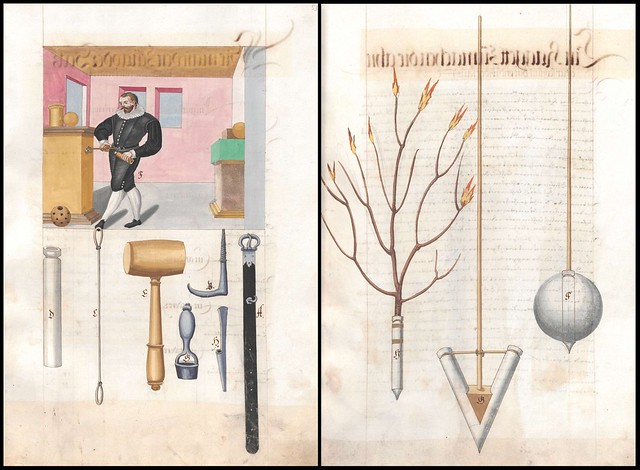
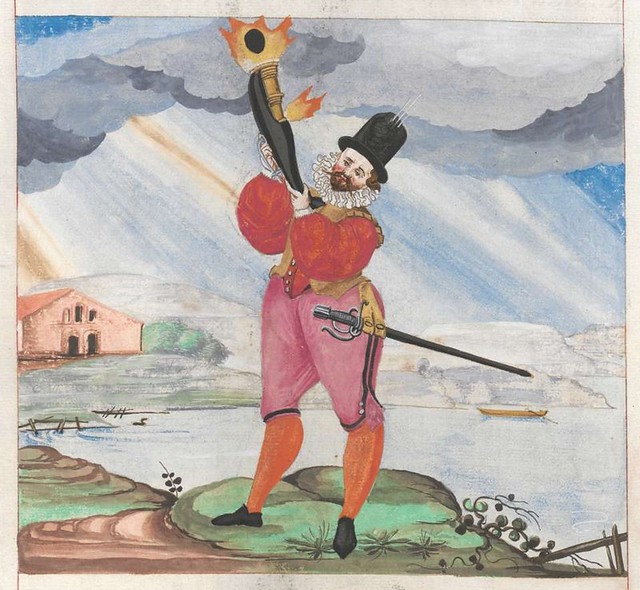
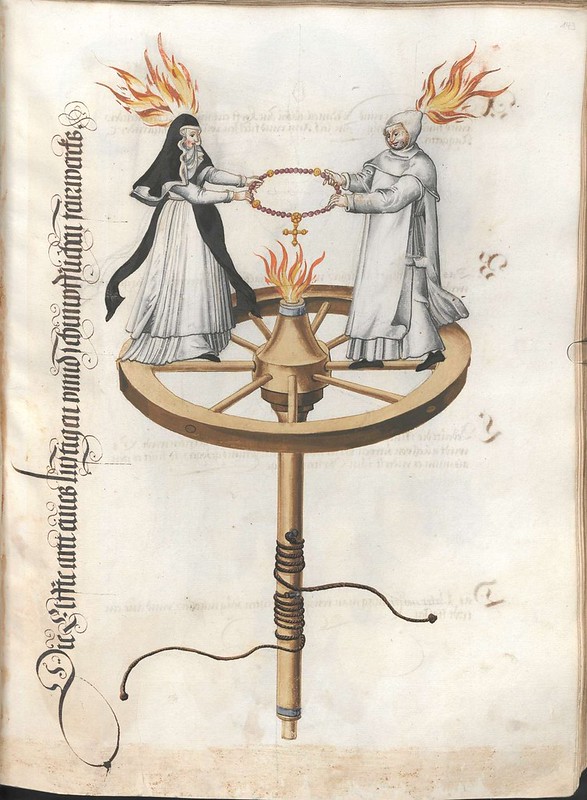
"The origins of fireworks lay in China, but European fireworks followed a distinctive development after their introduction from the east in the thirteenth to fourteenth centuries. Early European fireworks were used for war, with rockets, bombs, fire tubes, and grenades being hurled against enemies through the fifteenth and sixteenth centuries.
There were also peaceful fireworks, adding drama to church plays and festivals with squibs attached to flying angels or pyrotechnics made to represent the fiery mouth of Hell.
In the sixteenth and seventeenth centuries, the fireworks of the battlefield and the church slowly merged into peaceful displays of military pyrotechnics, first in religious plays for the courts, and then in secular triumphs and performances based on classical allegories. By the close of the sixteenth century, many European courts employed gunner artificers to stage grand fireworks marking royal occasions, military victories, and the new year."
[by Simon Werrett (& others), from Werrett's essay, 'Watching the Fireworks' IN: Science in Context 24(2), 167–182 (2011), Cambridge University Press]
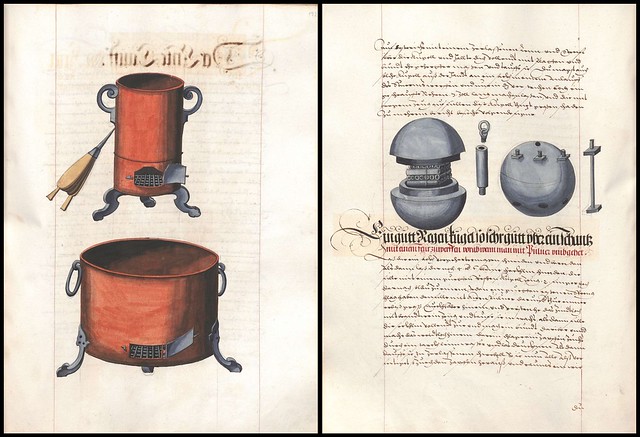

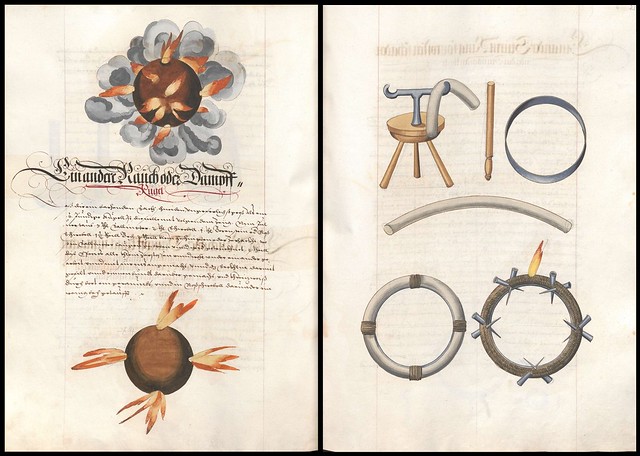



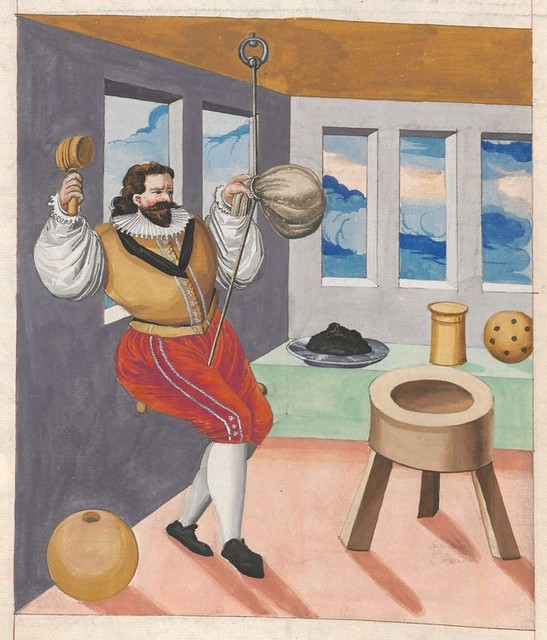
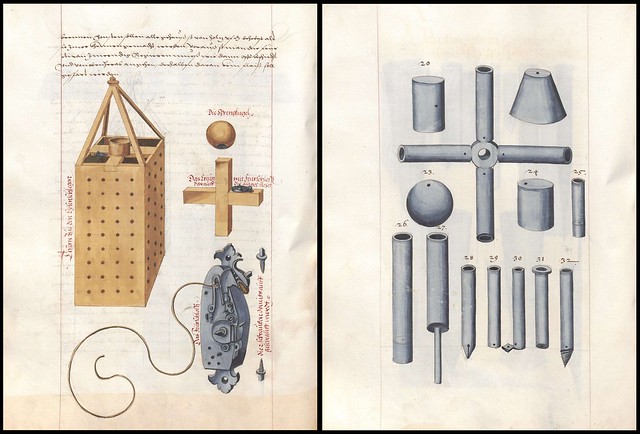





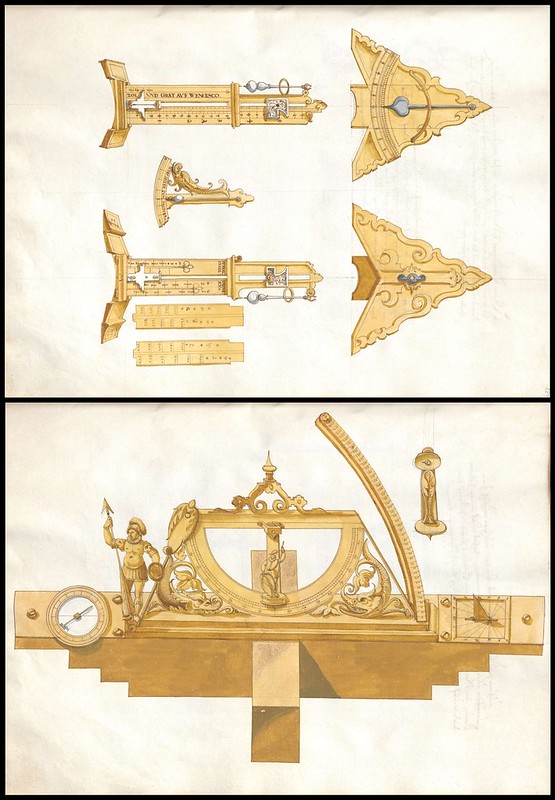




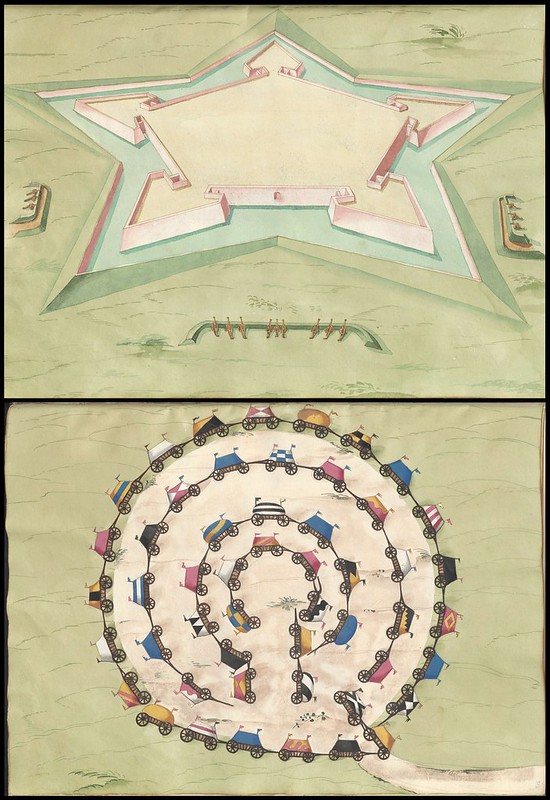
"Fireworks of the late sixteenth and early seventeenth centuries [.] amounted to a form of artificial nature, showing suns, stars, comets, fiery exhalations, snow, rain, thunder and lightning. These effects were considered extremely powerful and deeply impressed the princely patrons and courtiers who used them as tools of political distinction. This distinction hinged on knowledge or experience of pyrotechnics. The gentleman or courtier was expected to be virtuous, partly by the habit of reading, and numerous new books on fireworks were published in the sixteenth century to offer instruction in the creation of pyrotechnic effects. Those who understood or had familiarity with fireworks then experienced them as pleasing diversions, while those who did not were imagined to be terrified as if by natural portents."
[Simon Werrett's essay, 'Watching the Fireworks' IN: Science in Context 24(2), 167–182 (2011), Cambridge University Press]
I've always enjoyed the whole genre of gunpowder and pyrotechnics books and manuscripts from the Renaissance and Early Modern eras - see combat posts for previous related - despite my general ignorance for how the concepts of fireworks spectacle and artifice operated in the world hundreds of years ago. The illustrations are always colourful and attractive and make for good posting fodder on basic terms, of course. I mean, I had some inkling that fireworks way back then were fairly different, but I wasn't particularly aware of the breadth or meaning of their application nor (especially) how they were regarded by people.
Many reference commentaries on the early fireworks publications have tended towards narrow approaches: the chemistry, the manufacturers, various histories, the people involved etc. So the lack of references surrounding Meyer's manuscript featured above quickly (fortuitously) pointed me towards a few recent publications by historian Dr Simon Werrett. I don't pretend I've just become enlightened or even much smarter, but Werrett (and at least one other that he references, and no doubt a few others) considers the subject matter through a wider lens, involving social history, philosophy, physiology, alchemy, magic, religion and metaphorical systems (among other considerations no doubt), giving this esoteric material a more comprehensive and nuanced explanation. Hence, the Werrett-derived quotes dominating above.
- 'Büchsenmeister und Feuerwerksbuch' by Friedrich Meyer (or Mayer) 1594 is available on the website of the Bavarian State Library. It is nearly 600 pages long, with very few blank pages as I recall.
- 'Sparks of Life' 2009 by Simon Werrett in Cabinet Magazine online.
- 'Fireworks: Pyrotechnic Arts and Sciences in European History' 2010 by Simon Werrett.
- Dr Simon Werrett teaches the history and philosophy of science at University College London. Some of his essays are linked there although membership of hosting institutions is most likely(?) needed to obtain full papers. Thanks to KH for her help in that regard!
- 'Incendiary Art: the Representation of Fireworks in Early Modern Europe' by Kevin Salatino 1998.
- Previously on BibliOdyssey: combat.
- Elsewhere: @BibliOdyssey -- BibliOdyssey -- BibliOdyssey -- biblipeacay.
- ADDIT: I just found out that the rss feed has been broken for a month. And here was me thinking that everyone had fallen out of love with me considering the declining visitation stats of late. Anyway, it's all fixed, although it worries more than a little that Google owns feedburner, the carrier/publisher of this site's feed. Please let me know if things go awry on the rss front after July 1, 2013 when GoogleReader is terminated.
Illustrations by Mariana Santos

Behind every great man is a woman doing his transcriptions and data analysis
Thrift-score: mad, wonderful scrapbooks of 19th C Texas butcher who loved flying machines, secret societies
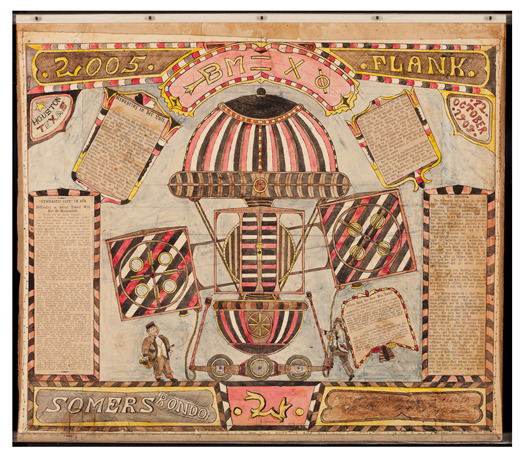
Robbo sez, "Charles Dellschau, a retired butcher in Texas in the late 1800's created a series of scrapbooks: '2,500 intricate drawings of flying machines alongside cryptic newspaper clippings filled the pages, crudely sewn together with shoelaces and thread' - it's an astonishing collection of mystery and whimsey with loads of drawings and plans for arcane flying machines, a secret society and coded messages strewn throughout. The books were found by a junk dealer in the 1960's and are now valued at $15,000 - per page."
These are astounding illustrations and amazing fantasies; they've been collected in a book called THE SECRETS OF DELLSCHAU: The Sonora Aero Club and the Airships of the 1800s, A True Story, which includes a lot of commentary on Dellschau's work and context.
He began with three books entitled Recollections which purported to describe a secret organization called the Sonora Aero Club. Dellschau described his duties in the club as that of the draftsman. Within his collaged watercolors were newspaper clippings (he called them “press blooms”) of early attempts at flight overlapped with his own fantastic drawings of airships of all kind. Powered by a secret formula he cryptically referred to as “NB Gas” or “Suppa” — the “aeros” (as Dellscahu called them) were steampunk like contraptions with multiple propellers, wheels, viewing decks and secret compartments. Though highly personal, autobiographical (perhaps!), and idiosyncratic, these artworks could cross-pollinate with the fiction of Jules Verne, Willy Wonka and the Wizard of Oz. The works were completed in a furiously creative period from 1899 to 1923, when air travel was still looked at by most people as almost magical. Newspapers of that period were full of stories about air travel feats and the acrobatic aerial dogfights of WWI were legend.
Dreams of the Sonora Aero Club [John Foster/Design Observer]
(Thanks, Robbo!)
Update: Here's an interesting, longer piece about Dellschau by Rebecca J. Rosen from the Atlantic
Brazil: June protests and demonstrations











